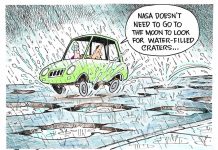Having made a living mostly through writing over the past half century, I have tended to question the accuracy of the phrase, “A picture is worth a thousand words.” I’m sure it originated with a photographer, but the image I came across on the front page of the sports section in The Republic’s Nov. 25 issue did go a pretty long way in telling a story.
It was a photo of Columbus North basketball player Stephon Peters-Smith firing a jump shot over the outstretched arm of a defender from visiting Heritage Christian. The story the photo told was not about Stephon’s shooting form — it looked pretty good — nor did it really capture the flavor of the game. North won 55-40 on its home court of Memorial Gym.
Actually the story the photo told was not about what took place on the playing floor. It was really about the scene behind the shooter and the defender — row after row of empty seats. The picture was striking to me because Memorial Gym was very much a part of my life in the late 1960s and early ‘70s when I was sports editor of The Evening Republican, forerunner of The Republic.
Those were the glory days of high school basketball, not only in Columbus but throughout Indiana. Memorial Gym had a seating capacity of just over 7,000, and every one of those seats was filled on game nights.
[sc:text-divider text-divider-title=”Story continues below gallery” ]
The Bull Dogs had some pretty good teams in that stretch and a few so-so squads. Nevertheless, tickets to home games were hard to come by. In some years tickets were allotted through a preseason draw. Games drew family members of coaches and players. They also attracted almost the entire student body of Columbus High School, many of whom were grouped together in cheer blocks for boys and girls.
More importantly, it drew people whose only connection to the high school and the team was that they lived in Columbus. Sam Simmermaker, who has broadcast local high school basketball games (and every other sport imaginable) for more than 50 years, calls these supporters “fan fans.”
“You just don’t see that many of these kind of supporters at games these days,” the veteran broadcaster said last week.”There’s just a plethora of other activities that get their attention. Look at all the choices that are available right here in Columbus — concerts, various meetings, social gatherings — then add in all of the other sports that are offered at the two high schools and the various teams that are fielded in those sports — C teams, reserve squads. Don’t forget that we have girls sports now. Back in the ‘60s and ‘70s, there weren’t any girls sports, and the high school basketball team had most of the fans to themselves. That’s just not the case anymore.”
Sam also points out that the competition for attention extends to the professional level. “Folks from Columbus today can go to Colts games or Pacer games,” he said. “That can siphon off entertainment dollars. Back in the ‘60s there wasn’t that kind of competition for entertainment dollars. Indianapolis didn’t have the Colts or Pacers.”
While there’s a vast divide between fan interest today and 50 years ago, the photo in the Nov. 25 issue might not be entirely reflective of the situation in place today. Sam points out that the background of empty seats is not necessarily an accurate piece of evidence. “The section in the photo is the visiting team’s area,” he said. “Heritage Christian may not be one of those schools that travels well (in bringing their own fan base to away games). Had North been playing a team like Hauser, I would imagine there would have been many more fans in the visiting section.”
Indeed, other photos of the game in which the home section is visible show a much denser fan base. Still, the nights of sold-out games have become a thing of the past. The decline in interest is not necessarily a reflection of any particular team’s ability or its won-lost record. It also shouldn’t be seen as a result of the division of Columbus High School into East and North.
Sam’s contention that the competition for people’s interests and the tremendous growth in sports teams at both schools have had the greatest impact is an accurate assessment. Still, for those of us who remember a time when all those seats were filled, many by people whose only reason for being there was to show support for the local team, the rows of emptiness are a sad sight.
The sport and the teams that play it haven’t changed all that much. However, we have.
Harry McCawley is the former associate editor of The Republic. He can be reached at [email protected].




